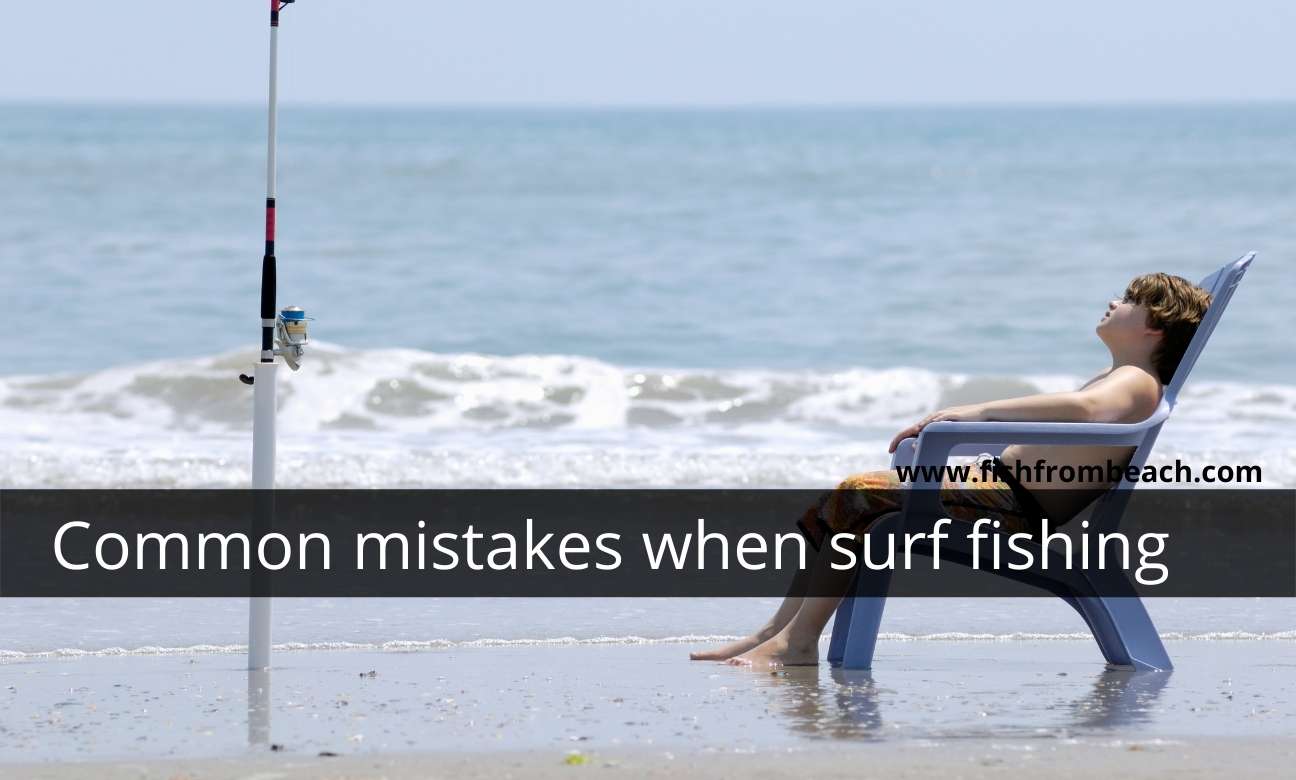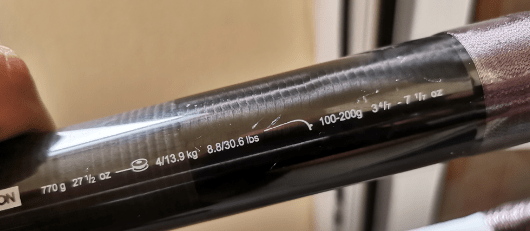
Mistakes are an inevitable part of surf fishing.
I mean, let’s face it, There is no surf angler who hasn’t made a fatal technical error that cost him what could be the biggest catch he’s ever had.
This is because fishing off the beach, by nature, makes it easy to commit mistakes. And I’m not even talking about mistakes like choosing the wrong equipment or fishing at the wrong time or in the wrong place. These can be easily avoided by doing your research and asking experienced local fishermen.
What I’m talking about here are the mistakes related to the technique and way of fishing. These can only be avoided by accumulating years of surf fishing expericene and by actually commiting a lot of mistakes.
That’s why I decided to write this article. I want to save you a lot of time, money, and lost catches, by informing you of 10 of the trickiest mistakes when surf fishing that are rarely mentioned, yet cause a lot of trouve for novice (and also experienced) anglers.
1- Loosening the line
This is the first mistake worth discussing. It’s easy to avoid and remember, yet many fishermen keep doing it over and over.
The rule here is simple. Keep your line tight all the time.
A tight line allows you to detect bites more easily, perform stronger hooksets, and be more stable in the surf zone.
It is therefore very important to keep your eyes on the line. If you see an arch starting to form, slowly reel in the line until it becomes straight again.
This is more critical during strong currents and inshore winds. Such conditions may push your terminal tackle towards the shore and, as a result, loosen your line.
2- Retrieving too hard
This mistake in simple words occurs when you rush to drag the fish and try to force it to the shore without giving it the opportunity to resist or back away.
Now, while this might work with the small fish that have low fighting abilities, going hard on the sizable species can lead to many terrible outcomes.
The fish you catch are at their best energy and power when they bite the hook. Therefore, opting for violence right after the bite can put your gear on a lot of stress, and possibly break something. It can be the line, rod or reel. But all in all, the enormous counter-force can damage your equipment.
Not to mention of course that it can also tear the hook from the fish’s mouth, allowing it to escape the trap and run away.
So what to do instead? Well, after the bite your goal should be to exhaust the fish, not to drag it to shore.
An exhausted fish, even if it is large, becomes much easier to drag and puts no risk on your setup.
So just after setting the hook, you have to keep the line at a balanced tension. Not too tight that the hook tears up the jaw of the fish, and not too loose that the fish finds it easy to spit the hook or move to covered areas.
There are many techniques to achieve that. The most common is as in the following steps:
- Reel in a few yards of line while slowly pointing the rod’s tip towards the sea.
- Slowly pull on the rod to make it upright again (you should feel the resistance here)
- Wait a few seconds until you feel the fish has calmed down.
- Repeat.
3- Retrieving too fast
Your casts do not finish when you decide to collect the line, but rather when your terminal tackle reaches the shoreline.
Why I say this? Because I see many fishermen go extremely fast when they pick up the line, as if they are 100% sure nothing will happen until the next cast.
This is a one of the biggest surf fishing mistakes.
When it comes to feeding, fish have irregular habits. Sometimes they go for the food, sometimes they wait for it to come thair way.
This is especially true when the water conditions are too harsh for the fish. For example, a chilly winter or scorching summer make most species too lazy and lethargic to forage for food. As a result, they spend most of the time motionless in their shelter and try to ambush their prey in case they pass by.
So the next time your cast doesn’t receive any bites, know that you still have a chance to get something while retrieving the line. Therefore, always go extremely slowly, try to cover as much ground as possible, and hold out hope until you see the hook under your feet.
4- Dragging the fish with the reel
Your reel is not designed to lift weights.
Yes, there are reels that are stronger than others and can handle more kilos, but the only role of a fishing reel is to collect the line.
Forgetting this rule will not only damage your spool and shorten its lifespan, but it can also cost you many big catches due to the continuous and excessive tension you create when you pull fish with the reel.
So never rely on the reel to drag the fish you catch. Instead, pull the fish with the rod, then use the reel to collect the excess of line you generate after every pull.
This creates intermetting periods of tight and loose line, which is the most guaranteed way to keep both the line and reel safe, and the fish securely on the hook 😉
5- Lifting fish with the rod
Make no mistake about the previous point. Yes, you have to use the rod to drag the fish, but this only applies when it is still in the water.
Once the fish reaches the land, use your hands to take it, not the rod.
Lifting fish (especially larger ones) with the rod puts it under significant stress and therefore initiates its damage.
So if you want to take pictures with your catch or show it to your friends, first unhook it, put the rod on the spike, and then go celebrate 😉
6- Opting for force during snags
If your terminal tackle tangles between snaggy rocks and refuses to come out, stop a few moments, take a deep breath, and accept the harsh reality:
Your tackle is very unlikely to come out just by trying to pull the line.
Using force during snags risks breaking your rod and reel before the line, which can send you home too early and heartbroken.
In such situations, I recommend that you go with one of the following methods:
1- If it’s an agitated surf, wait for the waves to pass over where you believe your gear is stuck, then gently retrieve the line with both the reel and the rod.
2- Tie a heavy piece of cloth to the line and let it slide along the wire until it reaches the water and starts moving seawards with the current. This creates opposing pressure on the stuck gear, which often helps it get out of the snag.
3- If none of the above solutions work, it’s time to cut the line. The best way to do this is to wrap the line a couple of times on the rod (preferably near the handle), make the rod and wire in a straight line, and then slowly back up with the rod in your hands. Most of the time, this techniques only breaks the knot conntecting the sinker or the weight, which keeps your rod and reel safe, and allows you to save a lot of line.
7- Turning on the light when night fishing
Night surf fishing can be very rewarding, but only if you don’t spook the fish and take them out of your casting range.
One way to scare off fish during a night session is to turn on the lights. So the rule here is simple. Do not use the lights when night fishing, except for the utmost necessity.
Personally, I only use the lights when renewing my baits or setting up my rigs. Sometimes also to check the size of my catches. But overall, I only turn on the light when I can’t perform without it, and I do so with my face pointing towards the land, not the water.
8- Overlooking the rating of the rod
This is one of the most common mistakes when surf fishing, and unfortunately it has a big impact on both productivity and personal finances.
Remember, your rod has limits in terms of sensitivity, speed, power, line weight, and lifting capacity. This information is usually on the rod itself as a set of numbers and letters.
For example, the pole below can only handle between 3 4/7 and 7 1/7 oz of casting weight and works best with pound tests between 8.8 and 30.6 pounds.

Now, will exceeding these intervals damage the rod? Not necessarily on the first use, but rigorous casting with too much weight and power and using stronger lines will gradually compromise the rod until it breaks one day.
The readings on the rod are also the recommendations for optimal performance in terms of balance, sensitivity, hooksetting, and bite detection.
So read about the rod you are using in order to fit everything else to it, including how you fish.
For more information, I invite to read the following articles:
- What is the difference between power and action of a fishing rod?
- The best rod action for surf fishing
- The best rod power for surf fishing
- How tall should a surf rod be?
9- Forgeting about the drag
A rod placed on a sand spike should never be left with a tight drag.
If your reel does not easily release the line under pressure and a heavy fish takes the bait, the line or rod may break and cost you both the big catch and the expensive equipment.
Depending on the spike, it is also possible for the rod to fall off and get pulled by the fish into the water.
So make sure to loosen the drag after the cast.
As a rule of thumb, your drag setting should be about 1/3 or 30% of the line strength.
For instance, if your pound test is 15 pounds, your drag should be about 5 pounds.
10- Not checking the line before the cast
There are some surf fishing mistakes that are difficult to avoid, yet they can have a disastrous effect on the fishing day.
Here is a good example.
When retrieving the line, renewing the bait, or putting on a new rig, it is easy for the line to get tangled and wrap around the tip of the rod. The problem is, it is quite difficult to detect that until the cast, which is too late as the force of the launch can break the line or the rod.
I have been through this, and I think it is not necessary to tell you how I felt that day. (Yes, that was the rod)
So always check the tip of your pole before the cast.
One way to check if the line is stuck is to turn the reel’s bail arm and allow some line to leave the spool. If the line comes out smoothly and without a problem, go ahead. if not, postpone the cast until you fix the problem.
Some recommended surf fishing gear(*)
Note (*): If you make a purchase through links from this website, we may get a small share of the sale from Amazon or other similar affiliate programs.
Surf Fishing Survey
Help us provide you with better content by answering simple questions about your surf fishing experience and knowledge.
We will put the collected responses together and turn them into valuable information that will help you catch more fish from shore 😉
Note: No personal information will be collected with your answer.

